Molecular Compatibility and Hydrogen Bonding Mechanism of PES/PEI Blends
Abstract
1. Introduction
2. Experimental
2.1. Materials
2.2. Preparation of Blended Hollow Fiber Membranes
2.3. Membrane Characterizations
2.3.1. DSC–TG
2.3.2. FTIR
2.3.3. XPS
2.3.4. XRD
2.3.5. SEM
2.3.6. Contact Angle Measurements of the Membranes
2.3.7. Mechanical Property of the Membranes
2.3.8. The Transportability, Anti-Fouling Performance of the Membranes
3. Results and Discussion
3.1. Thermal Stability of the Membranes
3.2. Functional Group Composition of the Membranes
3.3. Chemical Composition of the Membranes
3.4. Crystals of the Membranes
3.5. Membranes Morphology and Microstructure
3.6. Hydrophilicity of Membranes
3.7. Mechanical Performance of the Membranes
3.8. Transport Characteristics of the Membranes
4. Compatibility Calculation
5. Conclusions
Author Contributions
Funding
Institutional Review Board Statement
Informed Consent Statement
Data Availability Statement
Acknowledgments
Conflicts of Interest
References
- Yong, W.F.; Zhang, H. Recent advances in polymer blend membranes for gas separation and pervaporation. Prog. Mater. Sci. 2021, 116, 100713. [Google Scholar] [CrossRef]
- Benkhaya, S.; Lgaz, H.; Alrashdi, A.A.; M’Rabet, S.; El Bachiri, A.; Assouag, M.; Chung, I.-M.; El Harfi, A. Upgrading the performances of polysulfone/polyetherimide ultrafiltration composite membranes for dyes removal: Experimental and molecular dynamics studies. J. Mol. Liq. 2021, 331, 115743. [Google Scholar] [CrossRef]
- Yuan, X.S.; Liu, W.; Zhu, W.Y.; Zhu, X.X. Enhancement in Flux and Antifouling Properties of Polyvinylidene Fluoride/Polycarbonate Blend Membranes for Water Environmental Improvement. ACS Omega 2020, 5, 30201–30209. [Google Scholar] [CrossRef]
- Dhatarwal, P.; Sengwa, R.J. Polymer Compositional Ratio-Dependent Morphology, Crystallinity, Dielectric Dispersion, Structural Dynamics, and Electrical Conductivity of PVDF/PEO Blend Films. Macromol. Res. 2019, 27, 1009–1023. [Google Scholar] [CrossRef]
- Liu, Y.; Zhao, J.; Peng, Y.; Luo, J.; Cao, L.; Liu, X. Comparative Study on the Properties of Epoxy Derived from Aromatic and Heteroaromatic Compounds: The Role of Hydrogen Bonding. Ind. Eng. Chem. Res. 2020, 59, 1914–1924. [Google Scholar] [CrossRef]
- Liu, C.; Liu, Z.; Yin, X.; Wu, G. Tuning the Dynamic Fragility of Acrylic Polymers by Small Molecules: The Interplay of Hydrogen Bonding Strength. Macromolecules 2015, 48, 4196–4206. [Google Scholar] [CrossRef]
- Hu, N.; Zhang, Y.-S.; Sun, S.-T.; Zhong, L.-W.; Lei, Z.; Wu, P.-Y.; Yang, S.; Chen, E.-Q. Interchain Hydrogen Bonding Interaction Induced Phase Behaviors of Poly (ethylene oxide)-b-poly (N-vinylcarbazole)/Poly (acrylic acid) Blend. Macromolecules 2012, 45, 5546–5555. [Google Scholar] [CrossRef]
- Wang, C.F.; Ejeta, D.D.; Wu, J.Y.; Kuo, S.W.; Lin, C.H.; Lai, J.Y. Tuning the Wettability and Surface Free Energy of Poly (vinylphenol) Thin Films by Modulating Hydrogen-Bonding Interactions. Polymers 2020, 12, 523. [Google Scholar] [CrossRef] [PubMed]
- Han, D.; Chen, G.; Xiao, M.; Wang, S.; Chen, S.; Peng, X.; Meng, Y. Biodegradable and Toughened Composite of Poly (Propylene Carbonate)/Thermoplastic Polyurethane (PPC/TPU): Effect of Hydrogen Bonding. Int. J. Mol. Sci. 2018, 19, 2032. [Google Scholar] [CrossRef] [PubMed]
- Sarhan, A. Characterization of Chitosan and Polyethylene glycol Blend Film. Egypt. J. Chem. 2019, 2, 405–412. [Google Scholar] [CrossRef]
- Feng, Y.; Chung, T.-S. Fabrication and applications of polyethersulfone hollow fiber membranes. In Hollow Fiber Membranes; Elsevier: Amsterdam, The Netherlands, 2021; pp. 315–332. [Google Scholar]
- Huang, Y.; Xiao, C.; Huang, Q.; Liu, H.; Zhao, J. Progress on polymeric hollow fiber membrane preparation technique from the perspective of green and sustainable development. Chem. Eng. J. 2021, 403, 126295. [Google Scholar] [CrossRef]
- Ismail, A.F.; Rahim, R.A.; Rahman, W.A.W.A. Characterization of polyethersulfone/Matrimid® 5218 miscible blend mixed matrix membranes for O2/N2 gas separation. Sep. Purif. Technol. 2008, 63, 200–206. [Google Scholar] [CrossRef]
- Nasir, N.A.A.; Alshaghdari, A.G.A.; Junaidi, M.U.M.; Hashim, N.A.; Rabuni, M.F.; Rohani, R. Miscible blend polyethersulfone/polyimide asymmetric membrane crosslinked with 1,3-diaminopropane for hydrogen separation. J. Polym. Eng. 2021, 41, 607–614. [Google Scholar] [CrossRef]
- Han, J.; Lee, W.; Choi, J.M.; Patel, R.; Min, B.-R. Characterization of polyethersulfone/polyimide blend membranes prepared by a dry/wet phase inversion: Precipitation kinetics, morphology and gas separation. J. Membr. Sci. 2010, 351, 141–148. [Google Scholar] [CrossRef]
- Chen, X.Y.; Kaliaguine, S.; Rodrigue, D. Polymer hollow fiber membranes for gas separation: A comparison between three commercial resins. In Proceedings of PPS-33: The 33rd International Conference of the Polymer Processing Society—Conference Papers, Cancun, Mexico, 10–14 December 2017; AIP Publishing: New York, NY, USA, 2019. [Google Scholar]
- Govardhan, B.; Chandrasekhar, S.S.; Sridhar, S. Purification of surface water using novel hollow fiber membranes prepared from polyetherimide/polyethersulfone blends. J. Environ. Chem. Eng. 2017, 5, 1068–1078. [Google Scholar] [CrossRef]
- Zhao, W.; Shi, B. Removal of Volatile Organic Compounds from Water by Pervaporation Using Polyetherimide-Polyethersulfone Blend Hollow Fiber Membranes. Sep. Sci. Technol. 2009, 44, 1737–1752. [Google Scholar] [CrossRef]
- Belukhichev, E.V.; Sitnikova, V.E.; Samuylova, E.O.; Uspenskaya, M.V.; Martynova, D.M. Films Based on a Blend of PVC with Copolymer of 3-Hydroxybutyrate with 3-Hydroxyhexanoate. Polymers 2020, 12, 270. [Google Scholar] [CrossRef]
- Li, Y.; Lin, D.; Xu, J.; Zhou, X.; Zuo, B.; Tsui, O.K.C.; Zhang, W.; Wang, X. Glass transition temperature of single-chain polystyrene particles end-grafted to oxide-coated silicon. J. Chem. Phys. 2020, 152, 064904. [Google Scholar] [CrossRef]
- Lou, D.; Hou, Z.; Yang, H.; Liu, Y.; Wang, T. Antifouling Membranes Prepared from Polyethersulfone Grafted with Poly (ethylene glycol) Methacrylate by Radiation-Induced Copolymerization in Homogeneous Solution. ACS Omega 2020, 5, 27094–27102. [Google Scholar] [CrossRef]
- Ti, Y.; Wen, Q.; Chen, D. Characterization of the hydrogen bond in polyurethane/attapulgite nanocomposites. J. Appl. Polym. Sci. 2016, 133, 43069. [Google Scholar] [CrossRef]
- Kuo, S.-W.; Shih, C.-C.; Shieh, J.-S.; Chang, F.-C. Specific interactions in miscible polymer blends of poly (2-hydroxypropyl methacrylate) with polyvinylpyrrolidone. Polym. Int. 2004, 53, 218–224. [Google Scholar] [CrossRef]
- Run, M.; Wang, J.; Yao, M.; Guo, L.; Wang, H.-J.; Ba, X. Influences of hyperbranched poly (amide-ester) on the properties of poly (butylene succinate). Mater. Chem. Phys. 2013, 139, 988–997. [Google Scholar] [CrossRef]
- Ding, Y.; Zhu, J.; Liu, D. Separation performance and mechanism of the novel modified polyether sulfone composite nanofiltration membrane for the detection on dissolved organic nitrogen. Water Environ. Res. 2021, 93, 1748–1761. [Google Scholar] [CrossRef]
- Burrell, M.C.; Chera, J.J. Polyetherimide (Ultem®) Spin Cast Films by XPS. Surf. Sci. Spectra 1999, 6, 18–22. [Google Scholar] [CrossRef]
- Stevens, J.S.; Byard, S.J.; Seaton, C.C.; Sadiq, G.; Davey, R.J.; Schroeder, S.L. Crystallography aided by atomic core-level binding energies: Proton transfer versus hydrogen bonding in organic crystal structures. Angew. Chem. Int. Ed. 2011, 50, 9916–9918. [Google Scholar] [CrossRef]
- Kanagaraj, P.; Huang, W.; Liu, C. Noncovalently Functionalized Sulfated Castor Oil-Graphene Oxide-Strengthened Polyetherimide Composite Membranes for Superior Separation of Organic Pollutants and Their Fouling Mitigation. ACS Appl. Mater. Interfaces 2020, 12, 37054–37066. [Google Scholar] [CrossRef] [PubMed]
- Zhu, X.; Zou, R.; Sun, P.; Wang, Q.; Wu, J. A supramolecular peptide polymer from hydrogen-bond and coordination-driven self-assembly. Polym. Chem. 2018, 9, 69–76. [Google Scholar] [CrossRef]
- Jang, Y.; Yoo, S.Y.; Gu, H.R.; Lee, Y.J.; Cha, Y.S.; You, L.; Noh, K.; Kim, J. Hydrogen-bonding networks of purine derivatives and their bilayers for guest intercalation. CrystEngComm 2016, 18, 62–67. [Google Scholar]
- Rudyak, V.Y.; Gavrilov, A.A.; Guseva, D.V.; Tung, S.-H.; Komarov, P.V. Accounting for π–π stacking interactions in the mesoscopic models of conjugated polymers. Mol. Syst. Des. Eng. 2020, 5, 1137–1146. [Google Scholar] [CrossRef]
- Chen, L.; Wang, H.; Liu, J.; Xing, R.; Yu, X.; Han, Y. Tuning the π-π stacking distance and J-aggregation of DPP-based conjugated polymer via introducing insulating polymer. J. Polym. Sci. Part B Polym. Phys. 2016, 54, 838–847. [Google Scholar] [CrossRef]
- Mansourpanah, Y.; Madaeni, S.S.; Adeli, M.; Rahimpour, A.; Farhadian, A. Surface modification and preparation of nanofiltration membrane from polyethersulfone/polyimide blend-Use of a new material (polyethyleneglycol-triazine). J. Appl. Polym. Sci. 2009, 112, 2888–2895. [Google Scholar] [CrossRef]
- Nazarian, M.; Mansourizadeh, A.; Abbasi, M. Preparation of Blend Hydrophilic Polyetherimide-Cellulose Acetate Hollow Fiber Membrane for Oily Wastewater Treatment. J. Appl. Membr. Sci. Technol. 2019, 23, 37–48. [Google Scholar] [CrossRef][Green Version]
- Correa, A.; de Nicola, A.; Scherillo, G.; Loianno, V.; Mallamace, D.; Mallamace, F.; Ito, H.; Musto, P.; Mensitieri, G. A Molecular Interpretation of the Dynamics of Diffusive Mass Transport of Water within a Glassy Polyetherimide. Int. J. Mol. Sci. 2021, 22, 2908. [Google Scholar] [CrossRef]
- de Nicola, A.; Correa, A.; Milano, G.; La Manna, P.; Musto, P.; Mensitieri, G.; Scherillo, G. Local Structure and Dynamics of Water Absorbed in Poly (ether imide): A Hydrogen Bonding Anatomy. J. Phys. Chem. B 2017, 121, 3162–3176. [Google Scholar] [CrossRef]
- Li, C.; Zhang, J.; Han, J.; Yao, B. A numerical solution to the effects of surface roughness on water-coal contact angle. Sci. Rep. 2021, 11, 459. [Google Scholar] [CrossRef]
- Fanta, G.M.; Jarka, P.; Szeluga, U.; Tanski, T.; Kim, J.Y. Phase Behavior of Amorphous/Semicrystalline Conjugated Polymer Blends. Polymers 2020, 12, 1726. [Google Scholar] [CrossRef] [PubMed]
- Li, S.; Cui, Z.; Zhang, L.; He, B.; Li, J. The effect of sulfonated polysulfone on the compatibility and structure of polyethersulfone-based blend membranes. J. Membr. Sci. 2016, 513, 1–11. [Google Scholar] [CrossRef]
- Chen, J.; Qiu, T.; Yan, W.; Faul, C.F.J. Exploiting Hansen solubility parameters to tune porosity and function in conjugated microporous polymers. J. Mater. Chem. A 2020, 8, 22657–22665. [Google Scholar] [CrossRef]
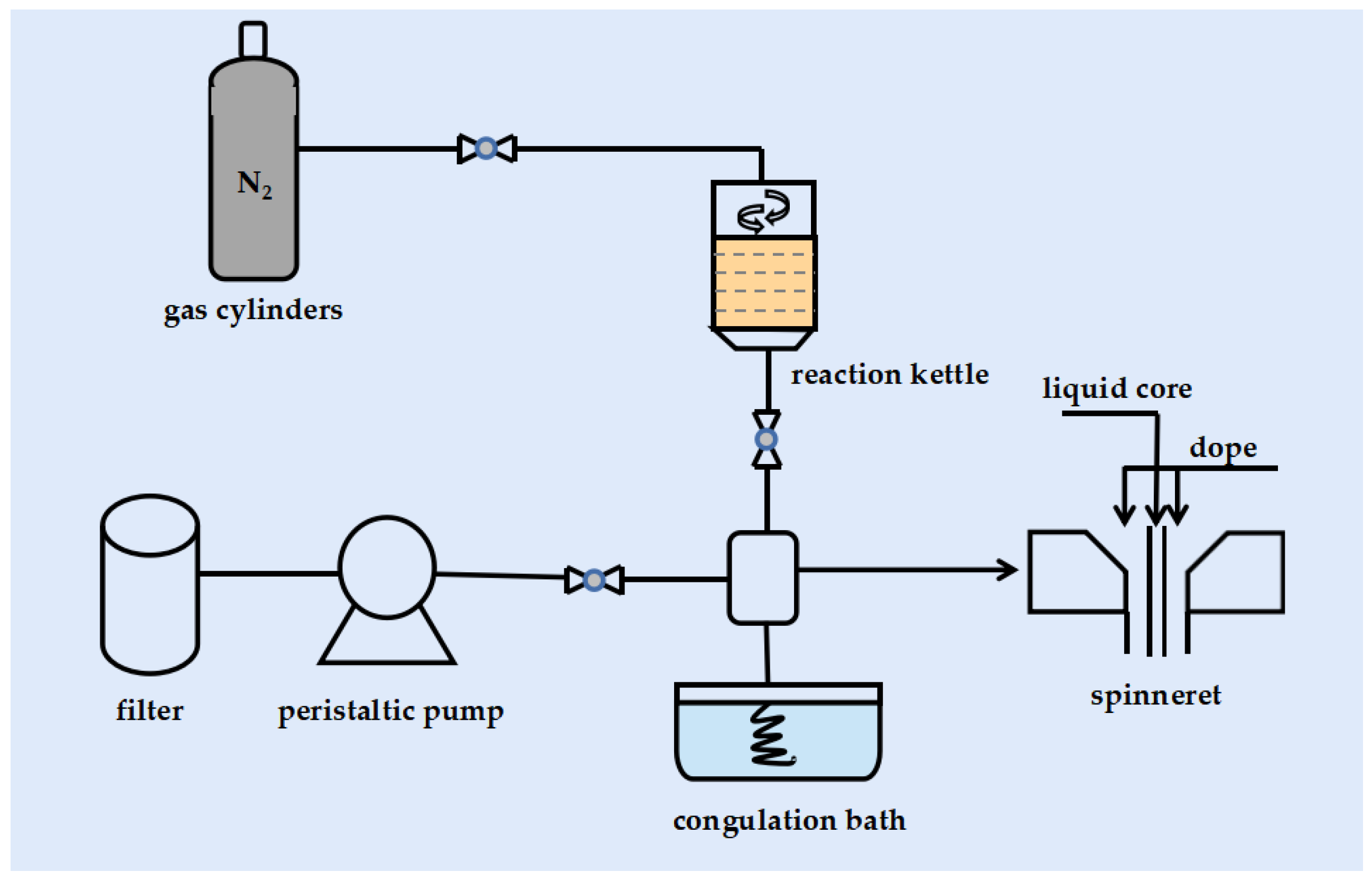
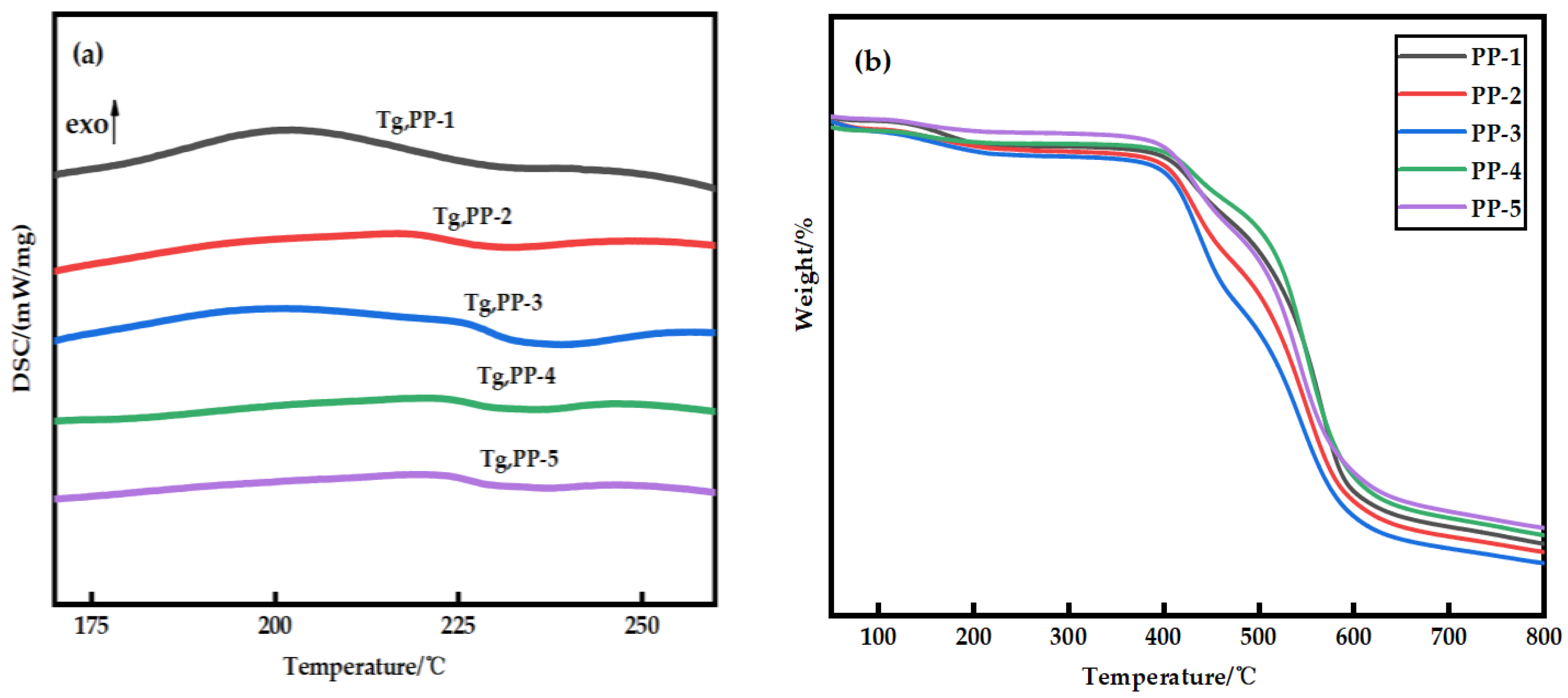


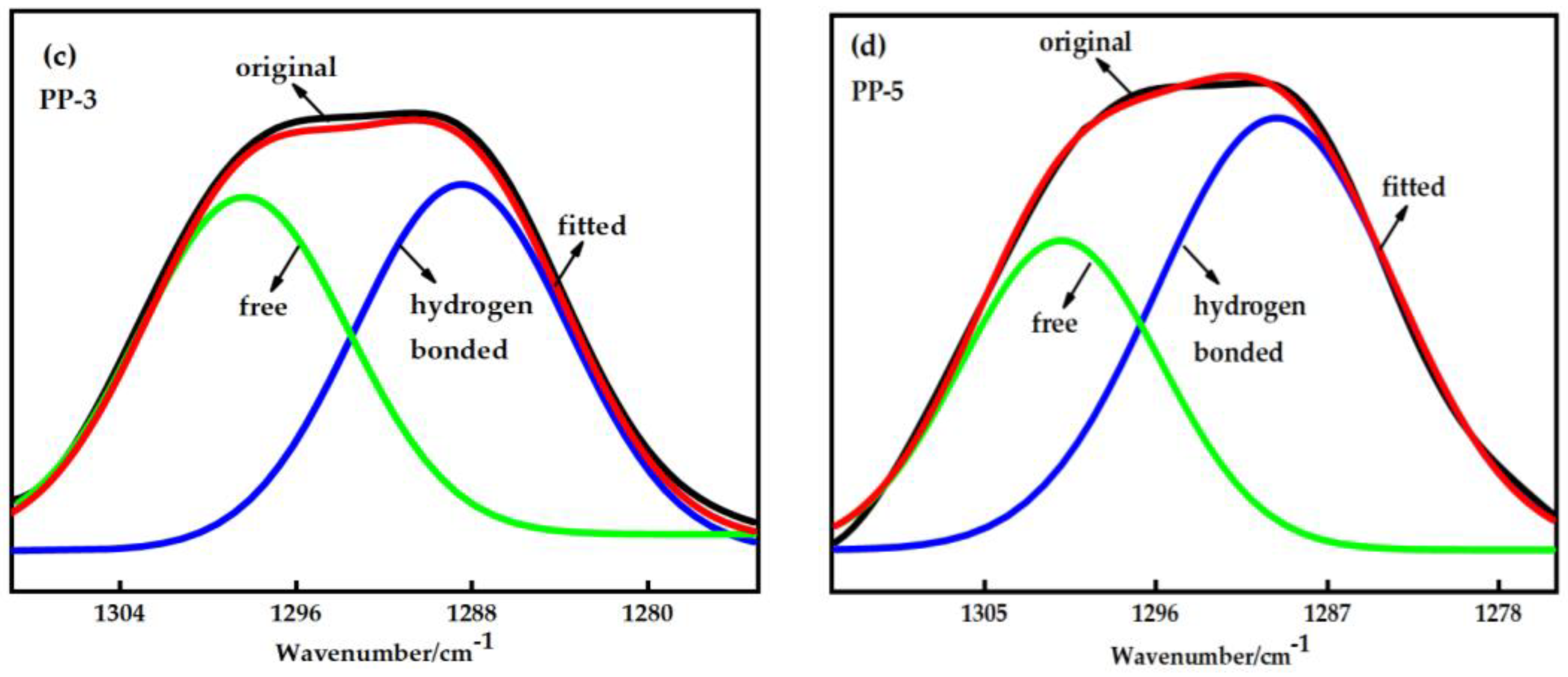
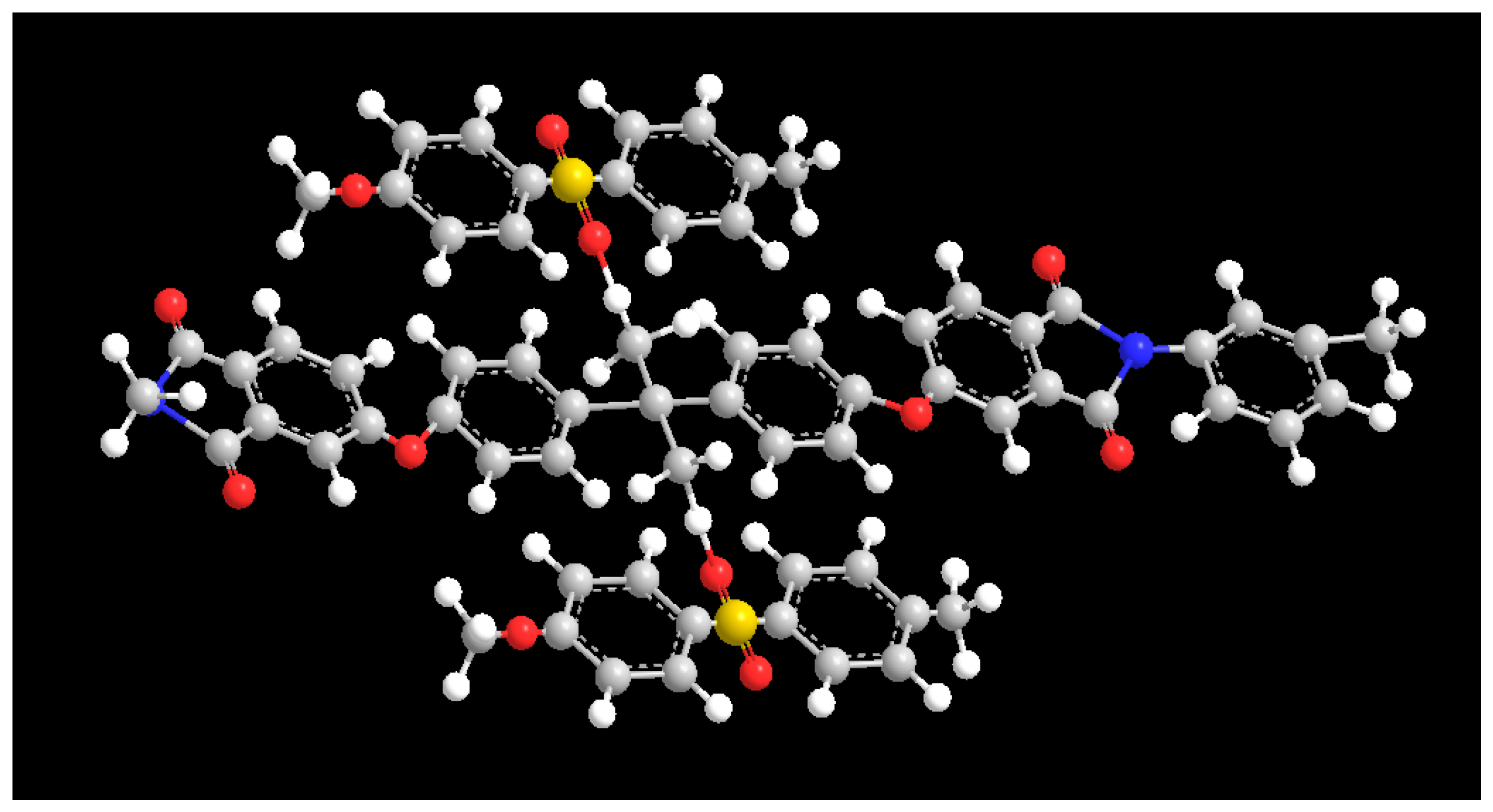
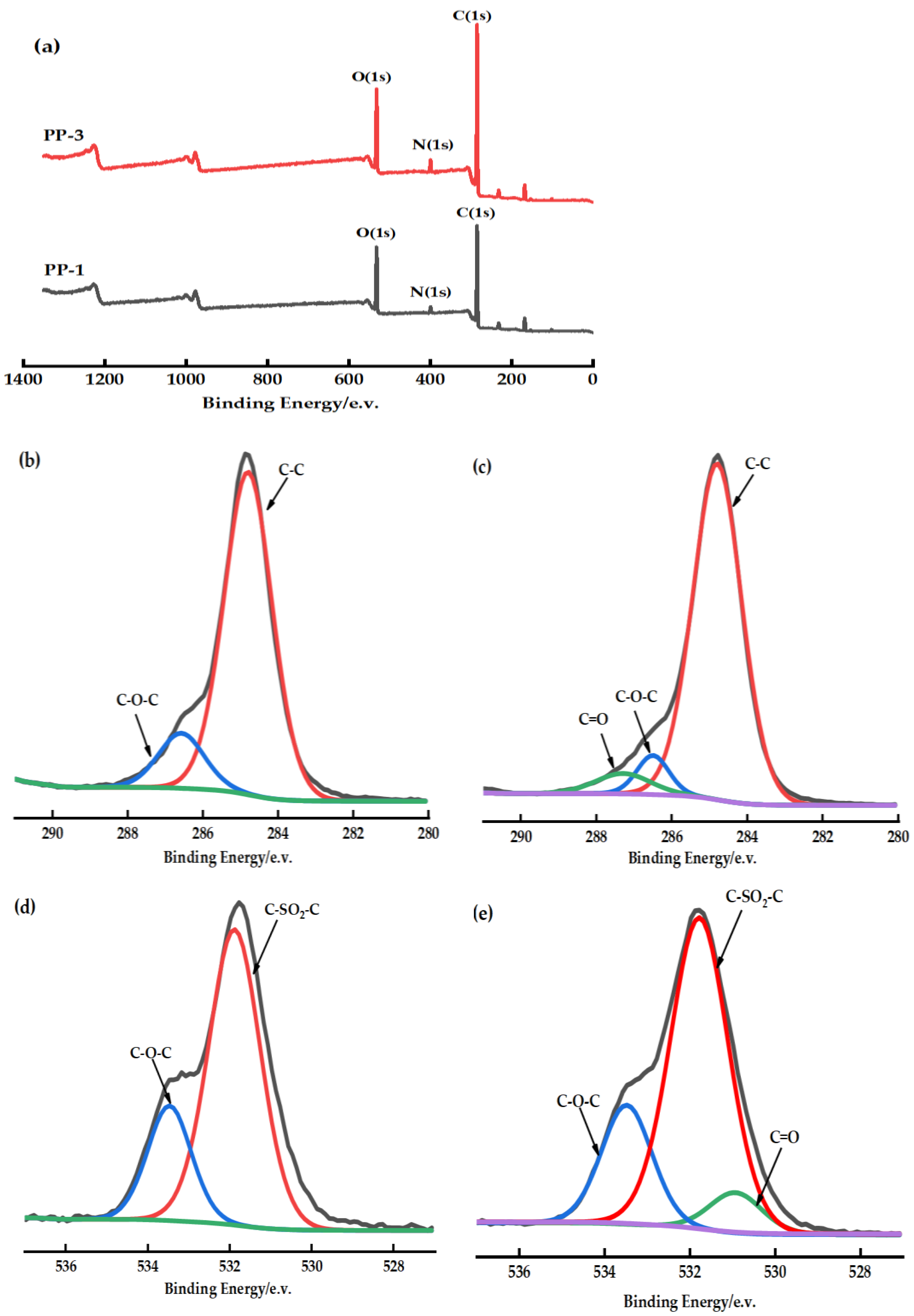
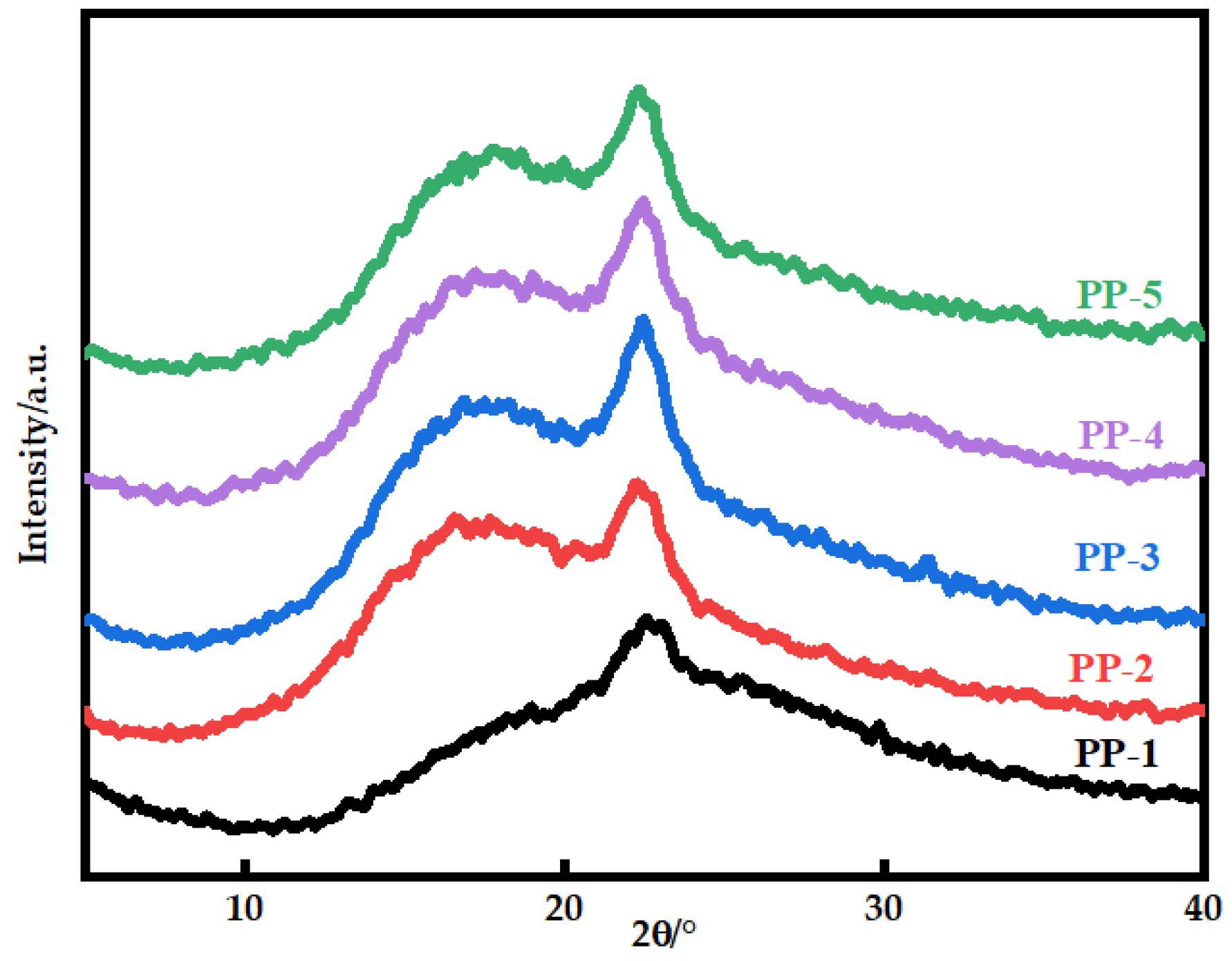
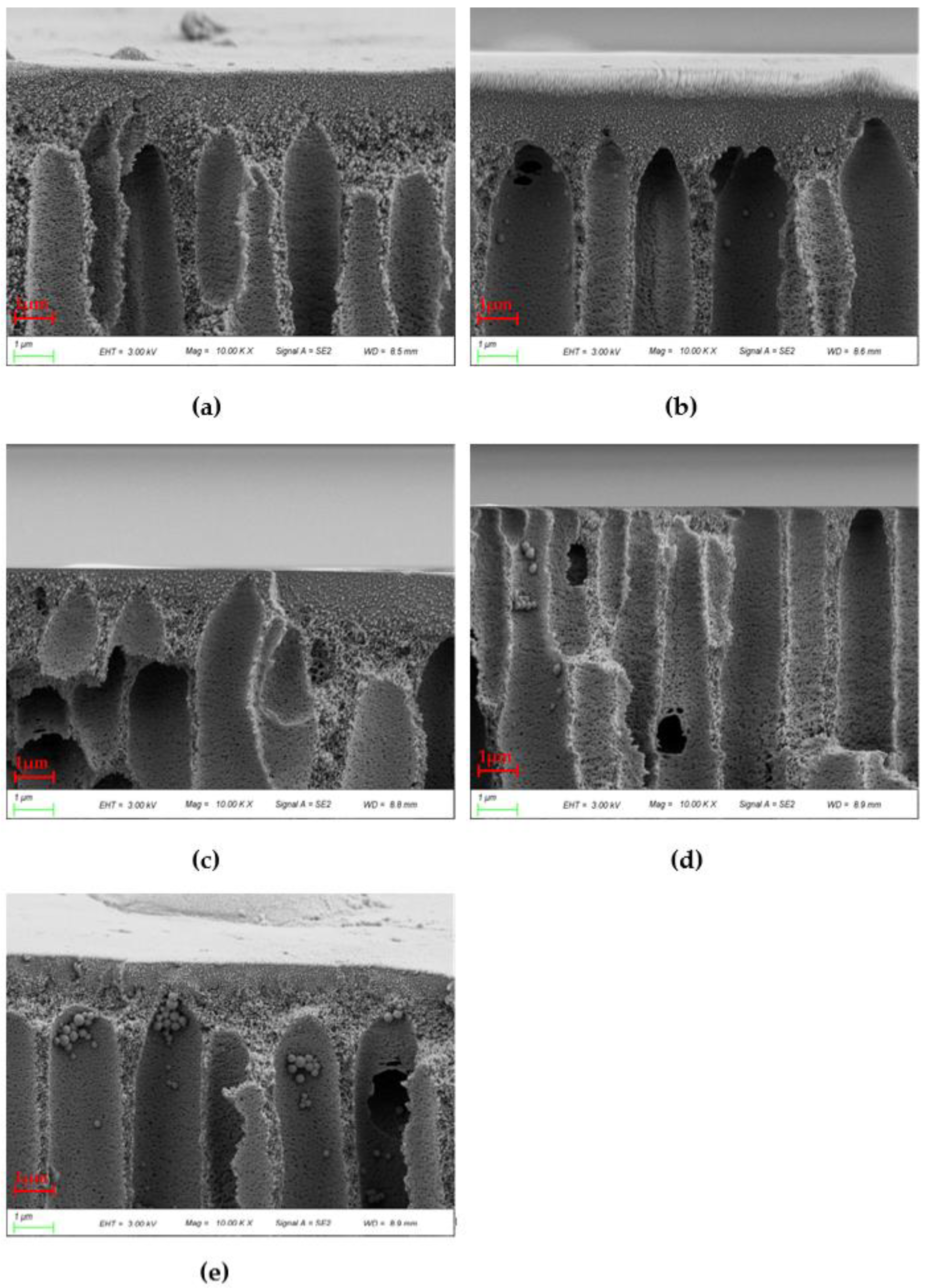
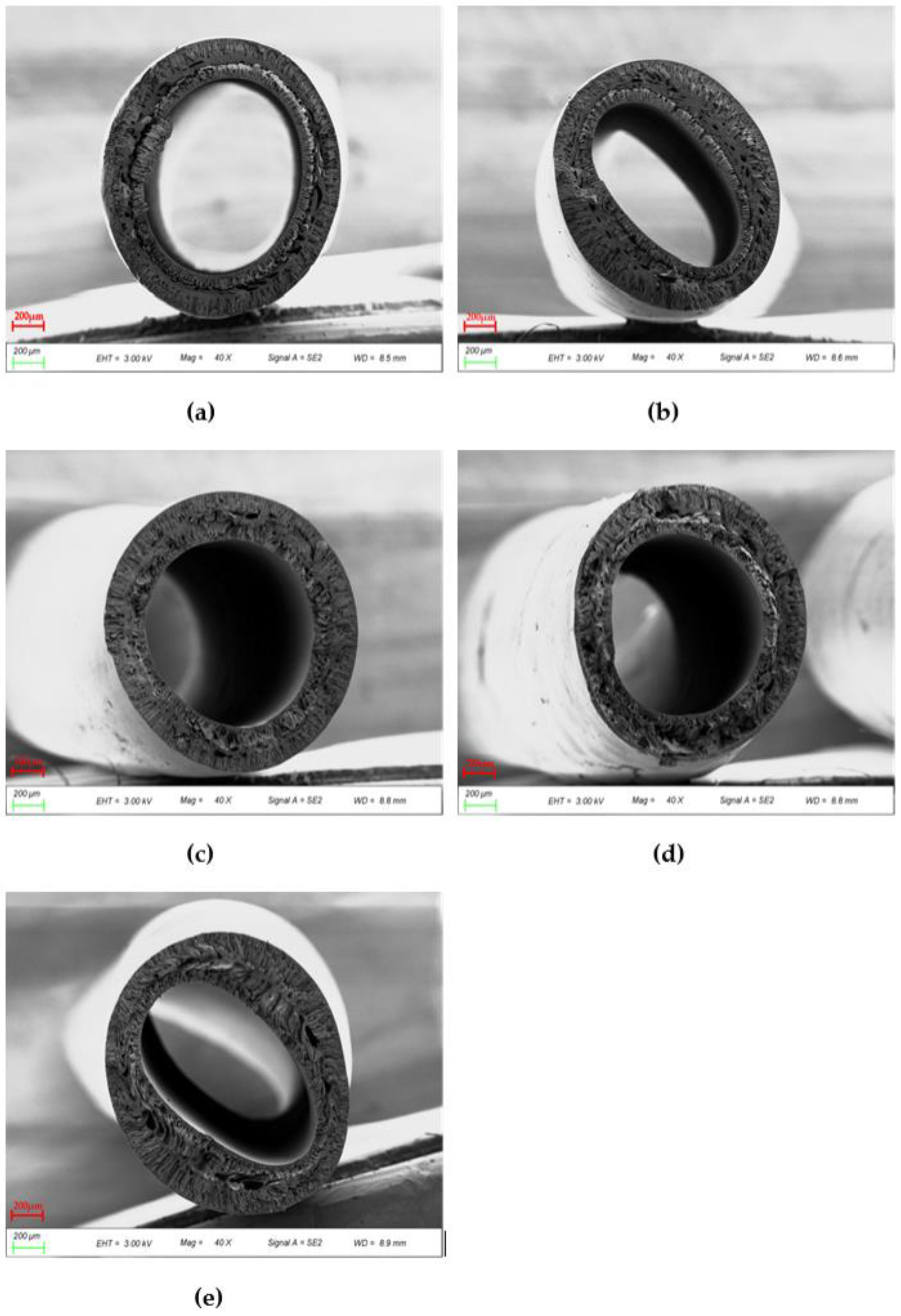
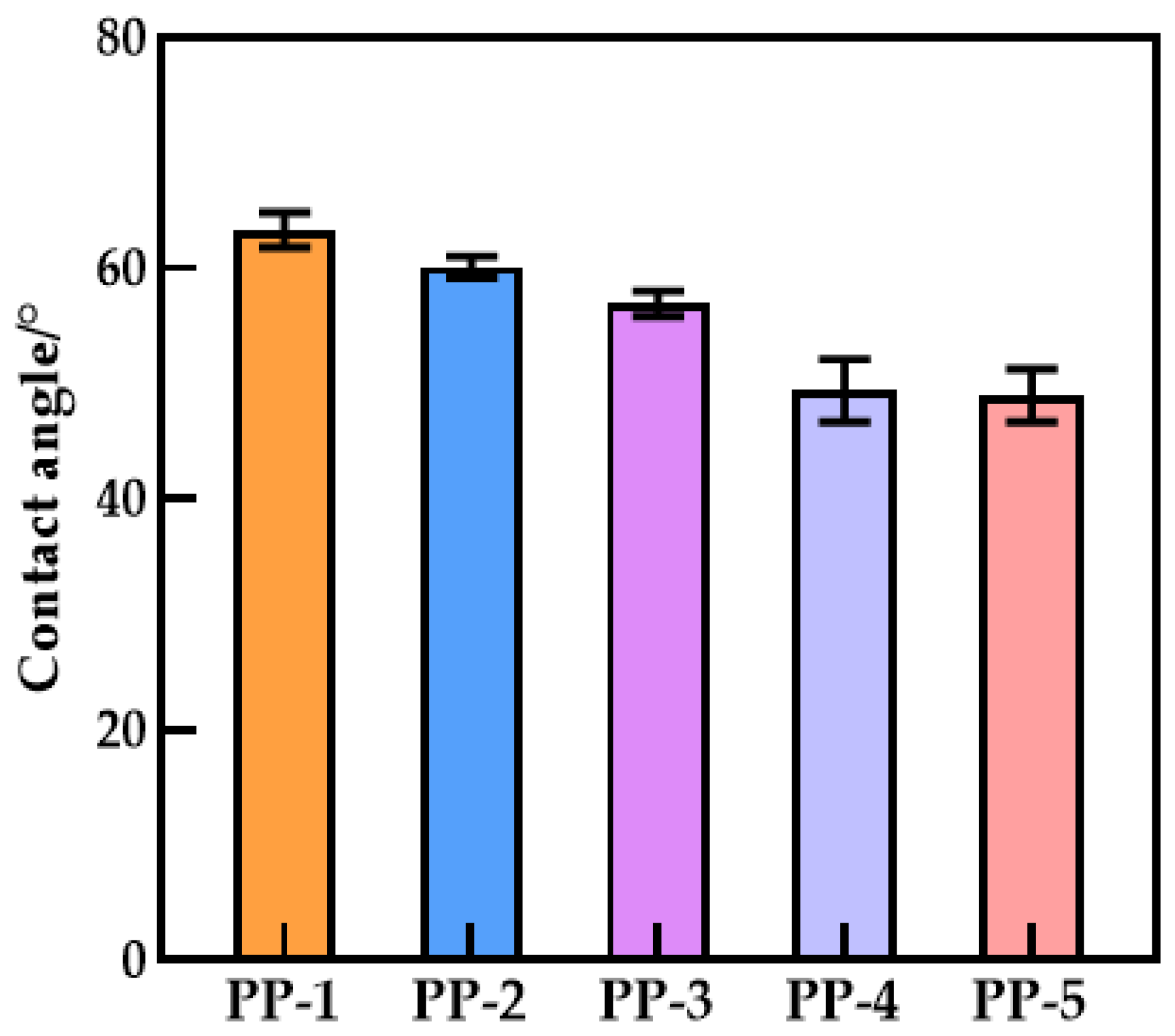

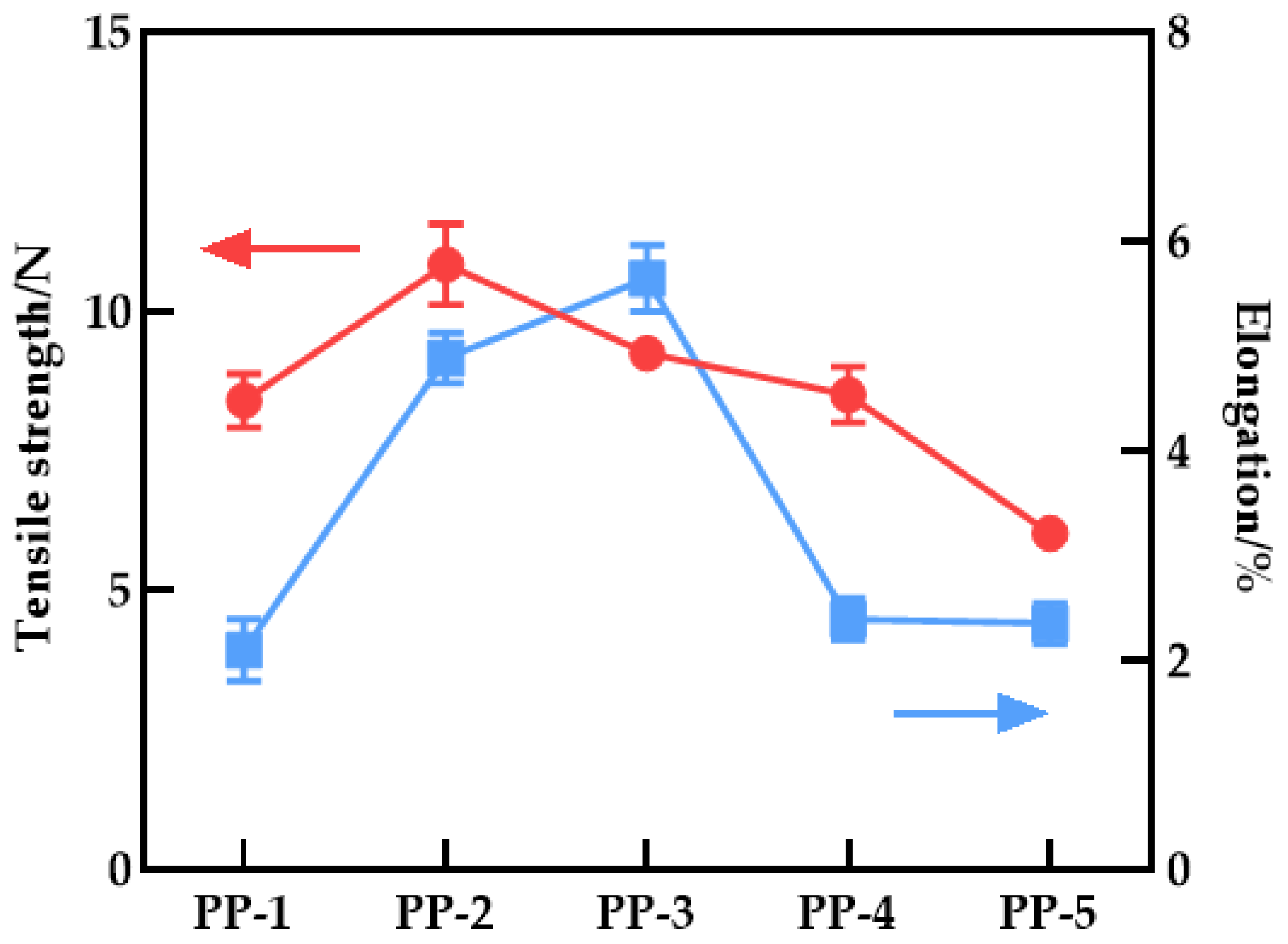
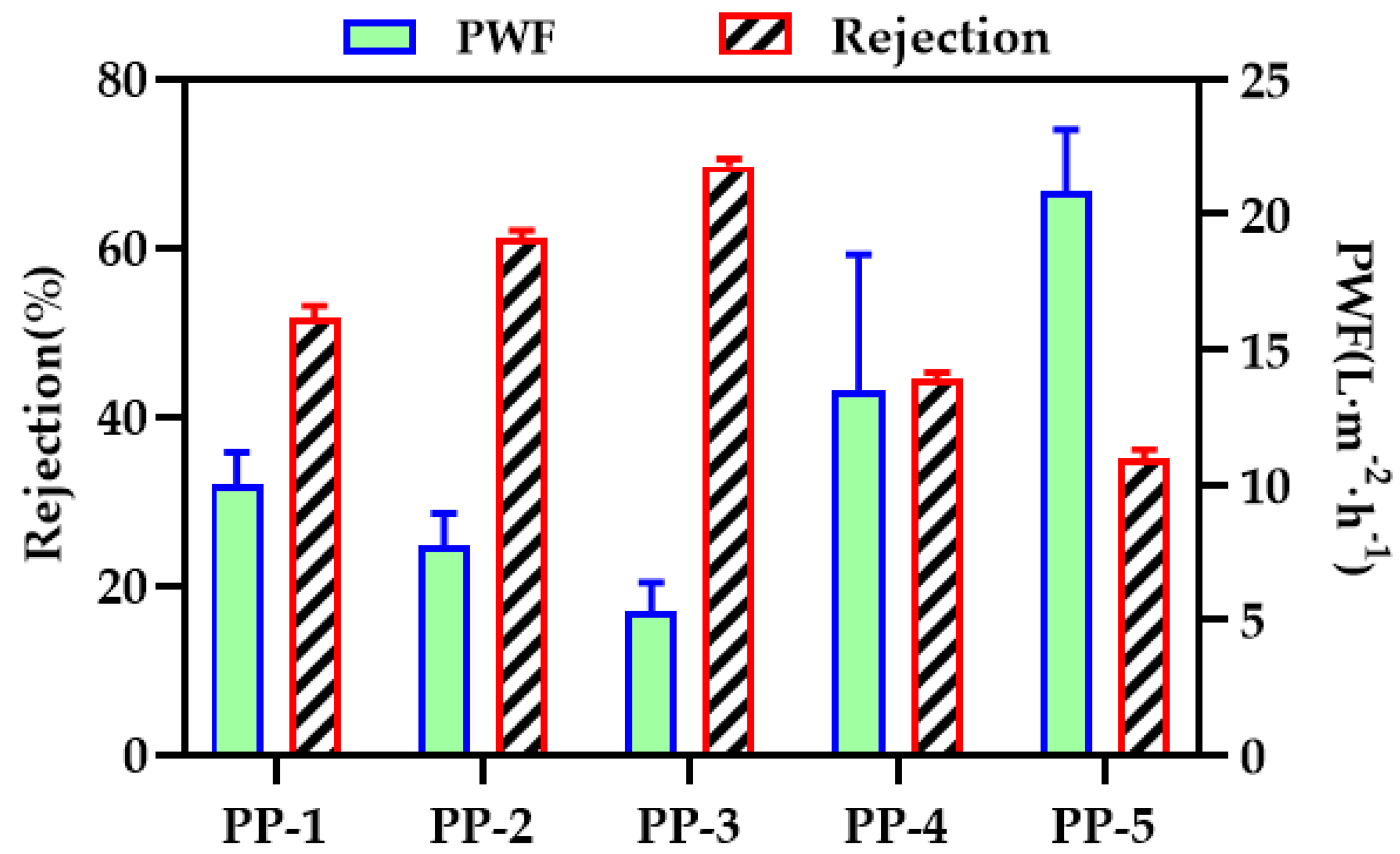
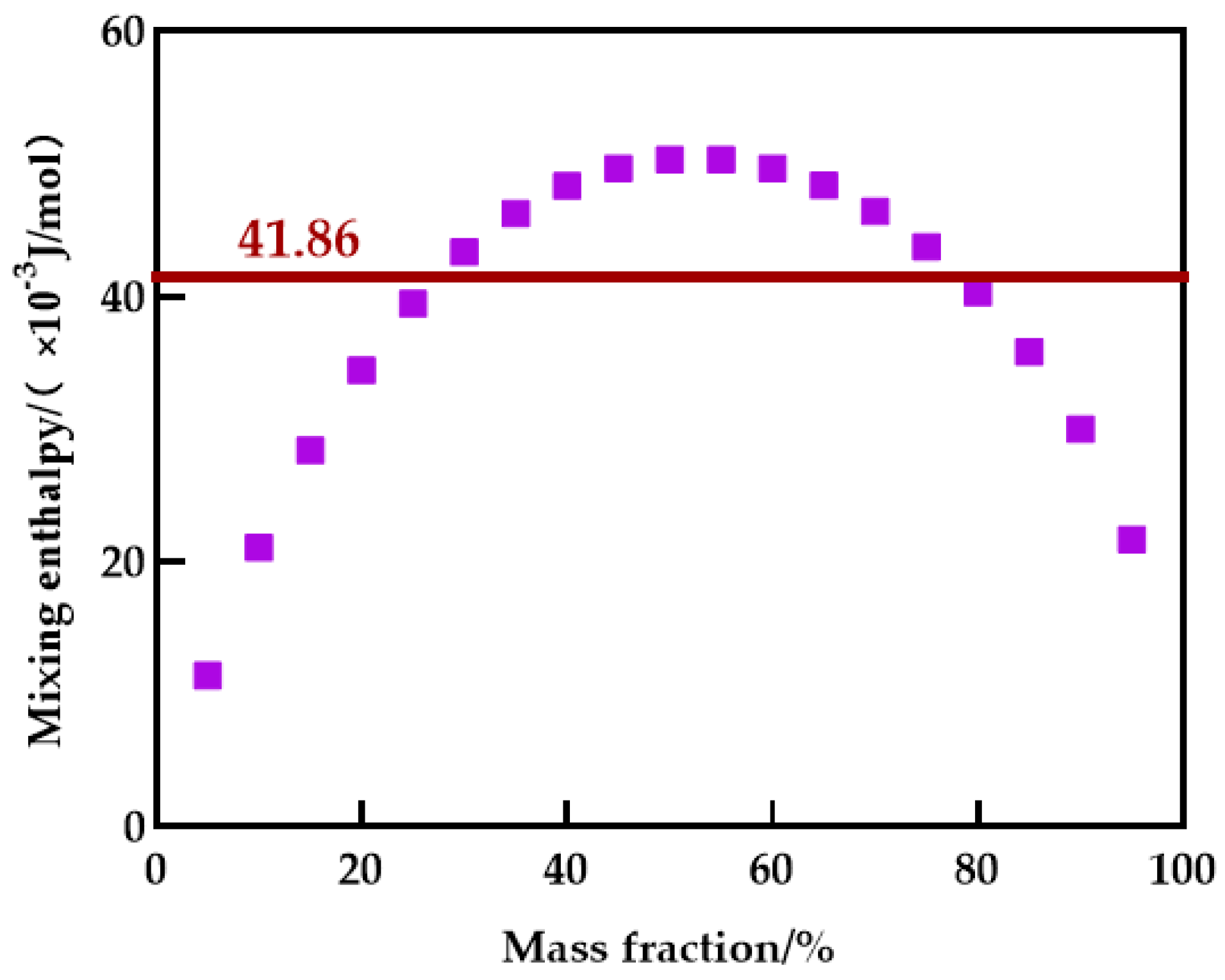
| Polymer | Chemical Structure |
|---|---|
| Polyethersulfone |  |
| Polyetherimide |  |
| Polymer | MW | MN | MW/MN |
|---|---|---|---|
| Polyethersulfone | 75,000 | 39,000 | 1.9 |
| Polyetherimide | 50,000 | 25,000 | 2 |
| Code | PES/PEI (27 wt.%) | DMAc (68 wt.%) | PVP (5 wt.%) |
|---|---|---|---|
| PP-1 | 100/0 | 68 | 5 |
| PP-2 | 95/5 | 68 | 5 |
| PP-3 | 90/10 | 68 | 5 |
| PP-4 | 85/15 | 68 | 5 |
| PP-5 | 80/20 | 68 | 5 |
| Sample | Total Area of -SO2− | Area of H-Bonded -SO2− | Area of Free -SO2− | F H-bonded (%) |
|---|---|---|---|---|
| PP-3 | 2239.14 | 1187.75 | 1051.39 | 53.04 |
| PP-5 | 4274.88 | 2678.30 | 1596.58 | 62.65 |
| Membrane | C (%) | O (%) |
|---|---|---|
| PP-1 | 75.06 | 20.79 |
| PP-3 | 77.76 | 17.59 |
| Membrane | 2 θ/° | d (π–π)/Å |
|---|---|---|
| PP-2 | 22.02 | 4.03 |
| PP-3 | 22.38 | 3.97 |
| PP-4 | 22.48 | 3.95 |
| PP-5 | 22.62 | 3.93 |
| Polymer | ||||||
|---|---|---|---|---|---|---|
| PEI | 3.64 | 10.33 | 3.45 | 11.48 | 1.27 | 622 |
| PES | 5.08 | 8.60 | 3.81 | 10.70 | 1.44 | 232 |
Publisher’s Note: MDPI stays neutral with regard to jurisdictional claims in published maps and institutional affiliations. |
© 2022 by the authors. Licensee MDPI, Basel, Switzerland. This article is an open access article distributed under the terms and conditions of the Creative Commons Attribution (CC BY) license (https://creativecommons.org/licenses/by/4.0/).
Share and Cite
Zhu, Y.; Wu, W.; Gao, M.; Yan, J.; Wang, B. Molecular Compatibility and Hydrogen Bonding Mechanism of PES/PEI Blends. Polymers 2022, 14, 3046. https://doi.org/10.3390/polym14153046
Zhu Y, Wu W, Gao M, Yan J, Wang B. Molecular Compatibility and Hydrogen Bonding Mechanism of PES/PEI Blends. Polymers. 2022; 14(15):3046. https://doi.org/10.3390/polym14153046
Chicago/Turabian StyleZhu, Yuanlu, Weixing Wu, Ming Gao, Jiangyi Yan, and Beifu Wang. 2022. "Molecular Compatibility and Hydrogen Bonding Mechanism of PES/PEI Blends" Polymers 14, no. 15: 3046. https://doi.org/10.3390/polym14153046
APA StyleZhu, Y., Wu, W., Gao, M., Yan, J., & Wang, B. (2022). Molecular Compatibility and Hydrogen Bonding Mechanism of PES/PEI Blends. Polymers, 14(15), 3046. https://doi.org/10.3390/polym14153046






